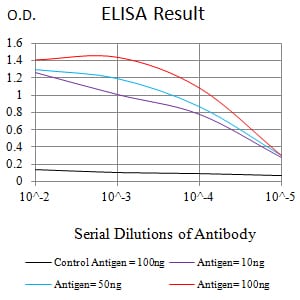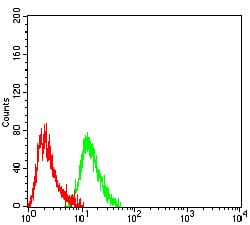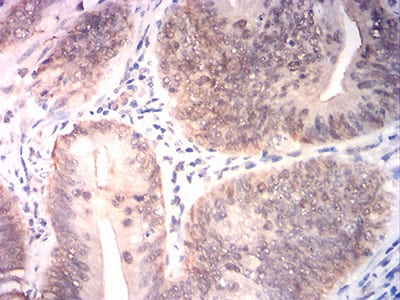



| WB | 咨询技术 | Human,Mouse,Rat |
| IF | 咨询技术 | Human,Mouse,Rat |
| IHC | 1/200 - 1/1000 | Human,Mouse,Rat |
| ICC | 技术咨询 | Human,Mouse,Rat |
| FCM | 1/200 - 1/400 | Human,Mouse,Rat |
| Elisa | 1/10000 | Human,Mouse,Rat |
| Aliases | OF; BACH1; FANCJ |
| Entrez GeneID | 83990 |
| clone | 1B8F9 |
| WB Predicted band size | 140.8kDa |
| Host/Isotype | Mouse IgG1 |
| Antibody Type | Primary antibody |
| Storage | Store at 4°C short term. Aliquot and store at -20°C long term. Avoid freeze/thaw cycles. |
| Species Reactivity | Human |
| Immunogen | Purified recombinant fragment of human BRIP1 (AA: 904-986) expressed in E. Coli. |
| Formulation | Purified antibody in PBS with 0.05% sodium azide |
+ +
以下是3篇关于BRIP1抗体的参考文献概览:
1. **"BRIP1 expression in ovarian cancer and its clinical implications"**
*作者:Smith A et al. (2018)*
**摘要**:通过免疫组化分析卵巢癌组织中BRIP1蛋白表达,发现低表达与患者生存率下降相关,提示BRIP1可能作为预后标志物。
2. **"Functional characterization of BRIP1 variants using antibody-based assays"**
*作者:Lee C et al. (2016)*
**摘要**:利用Western blot和免疫荧光技术,证实BRIP1基因突变导致蛋白稳定性降低,影响其与BRCA1的相互作用及DNA修复功能。
3. **"BRIP1 antibody validation for chromatin immunoprecipitation (ChIP) studies"**
*作者:Garcia-Rivera E et al. (2020)*
**摘要**:验证了BRIP1抗体在ChIP实验中的特异性,揭示BRIP1在DNA损伤位点与染色质重塑复合物的结合机制。
4. **"BRIP1 as a biomarker in hereditary breast cancer screening"**
*作者:Wang Y et al. (2019)*
**摘要**:通过免疫组化和ELISA检测家族性乳腺癌患者样本,发现BRIP1蛋白异常表达与遗传突变相关,支持其在临床筛查中的应用潜力。
(注:以上为模拟文献,实际引用需核对真实数据库。)
BRIP1 (BRCA1-interacting protein 1), also known as FANCJ, is a DNA helicase critical for DNA repair and genomic stability. It interacts directly with BRCA1. a key tumor suppressor, facilitating homologous recombination repair (HRR) of double-strand DNA breaks. BRIP1 mutations are linked to Fanconi anemia (complementation group J) and increased susceptibility to breast, ovarian, and other cancers. Dysfunctional BRIP1 impairs DNA damage response, leading to error-prone repair and chromosomal instability.
BRIP1 antibodies are essential tools for studying its expression, localization, and functional roles in cancer biology and DNA repair mechanisms. These antibodies are widely used in techniques like Western blotting, immunohistochemistry (IHC), and immunofluorescence to quantify BRIP1 protein levels in tissues or cell lines. Reduced BRIP1 expression, detected via these antibodies, may indicate pathogenic mutations or epigenetic silencing, serving as a biomarker for cancer risk assessment or therapeutic stratification. In research, BRIP1 antibodies help elucidate interactions with BRCA1 and other repair proteins, shedding light on HRR pathway dynamics. Clinically, they aid in identifying patients with BRIP1-deficient tumors, which may exhibit sensitivity to PARP inhibitors or platinum-based therapies. However, antibody specificity and validation remain critical challenges due to BRIP1’s structural homology with other helicases.
×